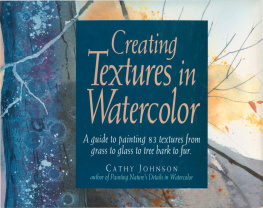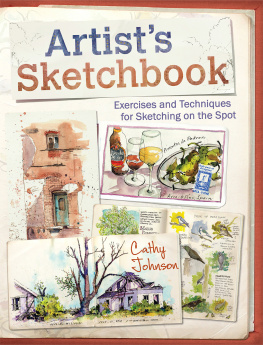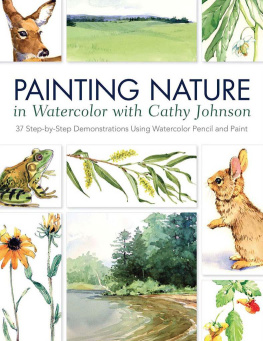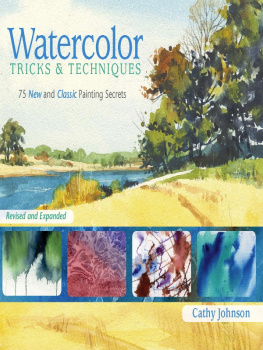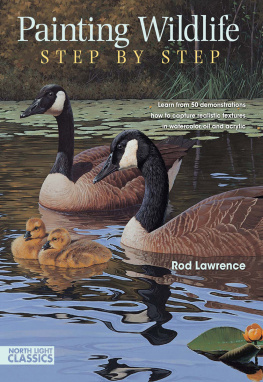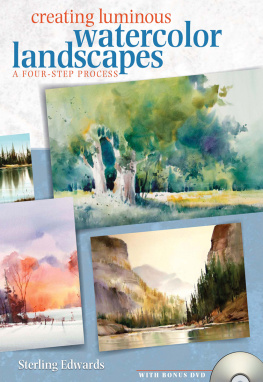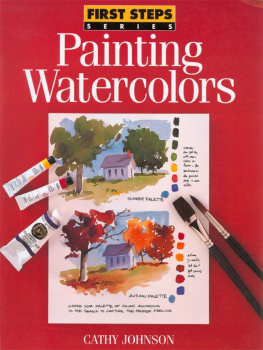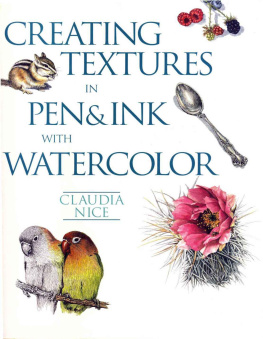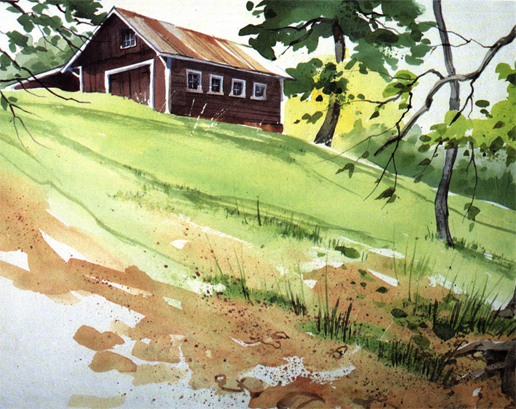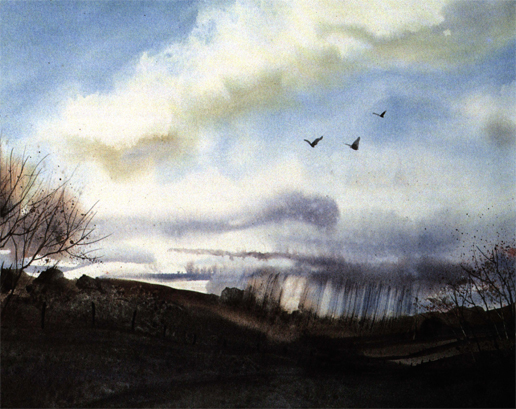Creating Textures in Watercolor
A guide to painting 83 textures from grass to glass to tree bark to fur.
CATHY JOHNSON

Cincinnati, Ohio
Creating Textures in Watercolor. Copyright 1992 by Cathy Johnson. All rights reserved. No part of this book may be reproduced in any form or by any electronic or mechanical means including information storage and retrieval systems without permission in writing from the publisher, except by a reviewer, who may quote brief passages in a review. Published by North Light Books, an imprint of F&W Publications, Inc., 1507 Dana Avenue, Cincinnati, Ohio 45207. First edition.
The Library of Congress has cataloged the print edition of this book as follows:
Johnson, Cathy (Cathy A.)
Creating textures in watercolor : a guide to painting 83 textures from grass to glass to tree bark to fur / Cathy Johnson.1st ed.
p. cm.
ISBN 0-89134-417-9 (hrdcvr)
1. Watercolor paintingTechnique. 2. Texture (Art)Technique.
I. Title.
ND2422.J64 1992
751.422-dc20 91-22587
CIP
Edited by Greg Albert and Rachel Wolf
Print edition designed by Sandy Conopeotis
DEDICATION
To my students,
whose intelligent questions
have helped to shape this hook;
to Greg Albert,
my supportive and meticulous
and understanding editor;
and to Harris,
whose presence makes it all possible.
CONTENTS
Chapter One
Paper Surfaces
Chapter Two
The Four S's
Chapter Three
Water Textures
Chapter Four
Foliage
Chapter Five
Tree Bark
Chapter Six
Earth, Pebbles, Sand
Chapter Seven
Rocks
Chapter Eight
Grasses & Weeds
Chapter Nine
Weathered Wood
Chapter Ten
Lichen & Moss
Chapter Eleven
Flowers
Chapter Twelve
Fruits & Vegetables
Chapter Thirteen
Fur
Chapter Fourteen
Hair
Chapter Fifteen
Skin Tones & Textures
Chapter Sixteen
Glass & Metal
Chapter Seventeen
Rust
Chapter Eighteen
Miscellany
INTRODUCTION
Everything has texturesurface characteristics you can feel or that affect the way a thing looks when the light hits it. Think of tree bark, rough grasses, polished glass, a baby's cheek, the glossy flanks of a thoroughbred horse. All these things share a common featurethey have a unique texture that contributes something essential to their identity.
You can capture these textures in watercolor to enhance the tactile appeal of your work. You can make each subject ring true by believably rendering soft or hard, rough or shiny, smooth or ridged surfaces. It's simply a matter of thinking through and planning ahead to capture the effect you're after.
There are those who say watercolor is trickyimpossible, at times!and so it can be, if you are only shooting for those exciting, spontaneous effects that produce what we call happy accidents. It's exciting, all right, but almost as dangerous as hang gliding without proper instruction. It takes practice to learn how to wing it without crashing.
Like learning to hang glide, watercolor takes practiceyou don't jump off a cliff without a good grounding in the basics. Capturing textures in watercolor is much the same.
Careful observation is one of the best keys to rendering surface texture, followed by a good dose of (right-brain) thinking. How does the light hit your subject? Is it oblique or straight on? What does that tell you about what you see? Does it enhance or flatten surface characteristics? And what should you paint first to get the effect you're after? What comes second? How far should you go? And what attracted you in the first place?
It isn't necessary to paint every hair on a kitten to capture the effect of soft fur, or to capture every light-struck detail of a cut-glass vase; these techniques are a sort of shorthand you can carry as far as you like. (However, if you are into photorealism, you can get there from here.) I prefer the simpler approach, and most of the examples in this book will reflect that simplicity.
This book includes techniques that depend heavily on the paper you choose; rough paper reacts quite differently than hot-press or plate, and if you are ready for that difference you can learn to use it to your advantage. Chapter One will lead you through the basics of paper surfaces.
Other basics depend on brushworkdrybrush, wet-in-wet, wet-onto-dry and vice versa. Watch for examples of these brush-handling techniques throughout to give you hints on which approach to choose with a specific subject.
Still other techniques are flashierI covered a number of these in my book, Watercolor Tricks and Techniques, but for the purposes of this book I've distilled them to the four S's: salt, scraping, sponges and spatter. Some are more useful than others, depending on you and your needs; I seldom use salt anymore but couldn't live without spatter. You'll find your own favorites to achieve the effects you're after.
The body of the book is more basic, a simple step-by-step, show-you-how-you-can-do-it. Not, mind you, a Here's how it's done approach, because everybody works differently. If the specific examples I've chosen aren't for you, skip them and try something else. Look beyond the surface. Even though I may be talking about smooth, shiny apples, the same basic technique applies to pears or eggplantto any shiny organic subject. If you like the texture I've achieved for rust but think it would work for you on moss instead, change the color and go for it.
Most of the examples in this book are step-by-step. I'll suggest an underwasheither simple or slightly more complexthen suggest ways you might manipulate the wash to create texture or suggest a secondary wash once the first is dry to layer on the texture. Final details add the spark needed to complete your subject, and you're through. In most cases, you'll let the wash dry thoroughly between stepsand that's what makes this approach so accessible and so much simpler (and more predictable) than many watercolor techniques. It takes patience to let the wash dry, or a good hair dryer, but the effects are well worth it. Your frustration level is almost guaranteed to drop.
This is not a new technique: there's nothing flashy about it. It's the traditional English style of watercolor, from a century or more ago. It's learning to control a difficult medium so that next time you want to jump on mat hang glider and run for the edge, you'll have the knowledge and the skill to do it. Enjoy the ride; the view is great.
This book is intended to be accessible and easy to use, like a workbook. The pages open wide to allow you to see what's going on more easily and to paint along if you like. I've used some of these samples in my workshop classes for years, and my students have enjoyed copying them. Usually they say, Tell me this is your next book! Well, it is, and I hope you find it as useful as they have.

